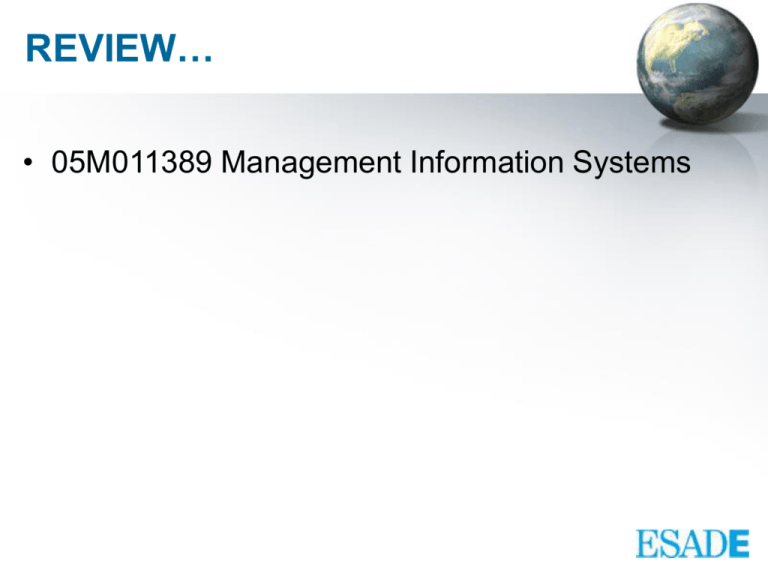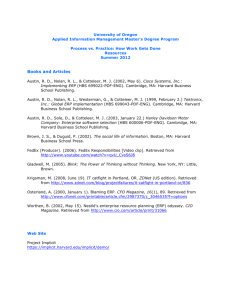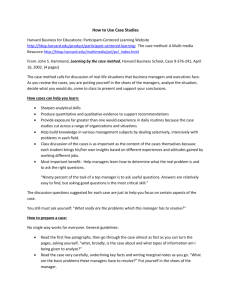Important
advertisement

REVIEW… • 05M011389 Management Information Systems Off-Shoring & Outsourcing 10 forces flattening the world… 1. 9/11/89 –Berlin Wall 2. 9/8/95 Netscape IPO & telecom deregulation 3. Computer-Computer connectivity XML, WS 4. Open Source 5. Out-sourcing 6. 7. 8. 9. 10. Off-shoring Supply Chaining In-sourcing Search engine & Internet Ubiquitous computing, digital convergence Session 1: Introduction • “A Conversation about Information Technology” Harvard Business School, 9-605-023 – Fun reading • “Information Technology Management from 19602000” Harvard Business School 9-301-147 – A reference for all subjects Session 2: Database • Hillyer. M “An Introduction to Database Normalization” http://dev.mysql.com – Know Normalization • “MySQL Open Source Database in 2004” Stanford Graduate School of Business Case SM-124 – Know about Database market, products and vendors – Know all about Open Source: philosophy, advantages, disadvantages and products Session 3: ERP • “Putting the Enterprise into the Enterprise System” Harvard Business Review, 2003. – Important • “Nestle´s ERP Odyssey” CIO Magazine, May 15 2002. – Important • Case: “Tektronix, Inc. Global ERP Implementation” Harvard Business School 9-699-043 – Exemplary Case – – – – Explain the logic and motivation of ERP Systems Describe the structure of ERP systems Explain some of the risks and problems of ERP implementations Evaluate the current ERP market and discuss its future Session 4: Supply Chain • The Power of Virtual Integration: An Interview with Dell Computer's Michael Dell, Harvard Business Review – Important • “Ford Motor Company: Supply Chain Strategy” Harvard Business School Case 9-699-198 – Exemplary Case • Jacobs, D. “Anatomy of a Supply Chain,” Supply Chain Technology News, March, 2003 – Important – Explain the motivation and structure of supply chain management software – Describe the implementation and operations of integrated supply chains – Assess the feasibility of supply chain integration in traditional manufacturing environments Session 5: XML • Johnston E. “An XML Primer” Technical Support 2000. – Important • Hagel J. “Web Services: Technology as a Catalyst for Strategic Thinking” – Important • Hagel J. “Your Next IT Strategy” Harvard Business Review, 2001 – Important • Articulate the philosophy of XML, its function, and application • Describe the logical structure, syntax, use of tags, elements, attributes, entities and characteristics of a well-formed XML document • Understand the function of a DTD and Schema • Understand "Web Services" as the evolving paradigm for computer to computer communication Session 6: CRM • Loveman D. “Diamonds in the Data Mine” Harvard Business Review 2003 – Important • Rigby D. and D. Ledingham “CRM Done Right” Harvard Business Review 2004 – Important • “Hendler R. and F. Hendler “ Revenue Management in Fabulous Las Vegas: Combing relationship management and revenue management to maximize profitability” Journal of Revenue and Pricing Management – Important • Explain the motivation and structure of customer relationship management software • Assess the risks of CRM implementation • Evaluate the potential of CRM systems to be integrated into other operational software components Session 7: Telecom & Wireless • Teleconglomerate” The Economist Feb 23, 2005. – Short, Important • “The Great telecom Crash” The Economist Jul 2002 – Short, Important • “The Telecom Crisis: Too many debts; too few calls” The Economist Jul 2002. – Short, Important • “IPv6 Enabling the Mobile Internet.” Nokia White Paper – Not important . Know what IPv6 is • Assess the current status of the telecommunications industry and describe its historical evolution • Discuss the motivation of IPv6 • Assess the current status and future trends of mobile telecommunications • Understand the philosophy of telecommunications regulation Session 8: Re-Engineering & Control • Hammer M. “Reengineering Work,: Don´t Automate, Obliterate” Harvard Business Review 1990 – Important • Gurbaxani, V. and S. Whang (1991) “The Impact Of Information Systems on Organizations and Markets,” Communications of the ACM 34,(1), pp. 59-73 – Important • Davenport, T. “Business Process Reengineering: Its Past, Present and Possible Future” Harvard Business School 9-196-082 – Important • Describe the historical origin of employee organization and control • Explain the philosophy of reengineering and describe its implementation • Assess traditional problems of employee motivation and control Session 9: IS Security • “How Hackers Break In, and How they Are Caught” Scientific American, October 1998 pp. 69-89. – Not important –but great reading!!! • Austin R. & D.R. Darby “The Myth of Secure Computing” Harvard Business Review. June 2003. – Important • Identify the major security risks in an organization's information system • Evaluate the relative advantages and benefits in the techniques used to control information systems security • Formulate general information systems security policies Session 10: Systems Integration • ““Toy Box: Managing Dynamic Digital Products” Teaching Case: Ivey School of Business – Exemplary case • “Xuma” Harvard Business School Case 9-601-170 – Exemplary case • Explain the need for, and challenges of, systems integration • Explain major tools of systems integration: Object Oriented Dev. & Design; XML… Session 11: B2C eCommerce • Novak, T. and D. Hoffman “Profitability on the Web: Business Models and Revenue Streams” eLab Position Paper 2001 – Semi-Important but a little old.. • Odlyzko A. “Privacy, Economics, and Price Discrimination on the Internet” Economics of Information Security 2004 – Important • Grover and Ramanlal. “Six Myths of Information and Markets: Information Technology Networks, Electronic Commerce and the Battle for Consumer Surplus” – Excellent review of theory • • • • • Analyze the history and current status of B2C eCommerce Describe predominant advertising models Assess trends in online advertising Describe the primary techniques of online customer segmentation Describe how framing effects influence online consumer behavior Session 12: B2B eCommerce • Malone, T. J. Yates and R. Benjamin “ Electronic Markets and Electronic Hierarchies” Communications of the ACM 1987 30, 6 pp. 484-497 – Important • “E-Stats” United States Department of Commerce April 15t, 2004 – Important • Understand and employ TCE as a tool to understand firm boundary formation • Identify the antecedents of Intermediated exchanges • Assess common business models in intermediaries and prescribe normative strategies • Describe the current status and trends in B2B eCommerce Off-Shoring & Outsourcing 10 forces flattening the world… 1. 9/11/89 –Berlin Wall 2. 9/8/95 Netscape IPO & telecom deregulation 3. Computer-Computer connectivity XML, WS 4. Open Source 5. Out-sourcing 6. 7. 8. 9. 10. Off-shoring Supply Chaining In-sourcing Search engine & Internet Ubiquitous computing, digital convergence Off Shoring • Watch Tom Friedmans video • “The other side of outsourcing” on youtube.com – Important • Describe current trends in systems development and other professional services in off shoring






